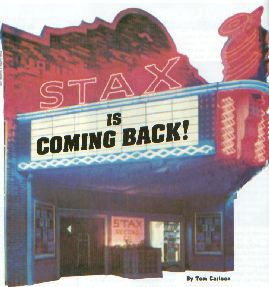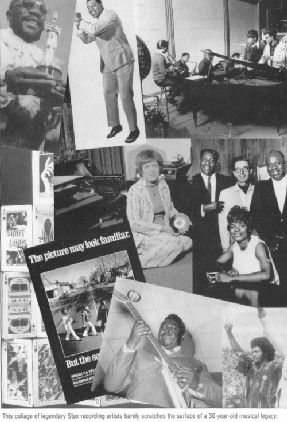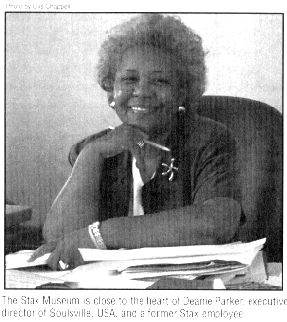
By Tom Carlson
SINDEX || NEWS || INFOS || FOCUS || ADS || LIST || LINKS || PHOTOS || E-MAIL
tax Records Memphis
Soul Music Rhythm & Blues Otis Redding Eddie Floyd Booker T.
& The MG's

By Tom Carlson
"Don't it always go to show
You don't know what you got til it's gone"
--Joni Mitchell
It's so Memphis. So American, really. Something thrives in your
civic midst that ends up defining your city. You're proud, of
course, but too busy to pay much attention. People from all over
the world enjoy it more than you do. You're just too darn busy.
Then, like anything else in this world, it inevitably suffers
rocky times. A shame, but ... the tax men come, followed by the
bulldozers, and the complaints from all over the world. Then, oh,
then, the collective realization: "You know, we really had
something there." And, finally, the decision, after looking
at the old photos, to try to put it back together.
|
|
It happened to much of Beale
Street. It almost happened to the Lorraine Motel. More recently,
it happened to Stax Records. Stax Records! Go to Paris, London,
Rome. Go to Irkutsk, Bucharest, Reykjavik, Nairobi, Kuala Lumpur:
Memphis is known for three things, and not one of them is
barbeque. One, tragically, is that Memphis is where Dr. Martin
Luther King, Jr., was murdered. The other two? Elvis, of course.
And third? Well, you simply have to group them: Isaac Hayes,
Booker T. and The MG's, Otis Redding, Sam and Dave, the Staple
Singers, et al. Which is to say Stax Records, a record company
responsible for feeding more rhythm and blues, more soul music,
not just into the national consciousness but into the
international consciousness, than any other organization this
side of Motown. And we bulldozed it.
But there are people now in Memphis, little ones, and big ones,
too - Deanie Parker, president and executive director of
Soulsville, the organization established in 1997 to coordinate
the rebirth of Stax, will gladly and enthusiastically name some
of them: Andy Capes, Charles Ewing, Kenneth Robinson, Stanley
Cates, and so many others whose cultural consciousness has been
raised; who, like so many of us now, realize what had been right
under our noses all along. A Memphis history. A Memphis musical
tradition. A Memphis Sound.
That's now, but back then-in the '80s and before that-it was
different.
Back in the late '50s, the record label had been called Satellite
Records. Its founders were First Tennessee banker Jim Stewart and
his sister, Estelle Axton. They eventually moved their operation
into the abandoned Capitol Theater at 926 East McLemore. A young
girl named Deanie, still in high school, went to work for them.
In 1961, Stewart took the first two letters of his last name (ST)
and added the first two letters of sister's last name (AX) and
the new label name, Stax, was born. The logo became a falling
stack of records.
From roughly 1960 to 1975, Stax Records in Memphis was the
epicenter of a unique brand of music embraced around the world.
We all know the litany: Isaac Hayes ("Shaft"), Booker T.
and The MGs ("Green Onions"), Otis Redding ("The
Dock of the Bay"),
Rufus Thomas ("Walking the Dog"), the Bar-Kays ("Soul
Finger"), the Staples Singers ("I'll Take You There,"
"Respect Yourself'), Luther Ingram ("If Loving You is
Wrong"), and on and on. Eight hundred singles. Three hundred
albums. Eight Grammies. One Oscar.
But in the mid 1970s, Stax began experiencing management and
financial difficulties. Bad decisions, lack of coordination,
overreaching, hanky panky, whatever: Stax Records, producers of
megahit after megahit, was forced into bankruptcy. Two years
later, the company sold its master tapes at bankruptcy auction to
Fantasy Records in California. In 1981, Union Planters deeded
Stax Recording Studios to the Southside Church of God in Christ
for one dollar. And in 1989, the church tore down the recording
studio.
The irony is, says Sherman Wilmott, curator of Soulsville and
owner of Shangri-la Records, that if it had been today, "it
never would have happened."
Even back then, there were people outraged at the prospect of
Stax becoming a weed-choked lot. "I've heard that people got
[former Shelby County mayor] Bill Morris to dispatch police cars
to block the bulldozers," says Deanie Parker, "while
people worked frantically downtown to get the proper paperwork to
halt the razing." All to no avail. The contents of the
building scattered, and in a matter of days, Stax was gone. In
body certainly, in building perhaps, but not in spirit. Almost
immediately, some people began planning a resurrection.
More than 35 years later, a civic group took the remaining letters of the Stewart and Axton names, and formed Ewarton, an organization dedicated to creating a living legacy to Stax. In 1997, it announced plans to build the Stax Museum of American Soul Music, a music academy, and a performing arts center on the site of the old Stax enterprise and adjacent to it. Ewarton later became the Soulsville organization, with a tiny staff of four people and two contract employees. With Executive Director Deanie Parker at the helm - Deanie who had been at Stax from the beginning, who had worn almost every hat the Stax organization had, who even wrote two songs that Otis Redding recorded ("Don't Mess with Cupid," and "You Sure Made a Man Out of Me"), and whose heart was broken at the end - they got down and got busy. The response was overwhelming.
Architectural plans were drawn for the building complex. The facade of Stax would be recreated, and the building would house a museum, with a reproduction of the Stax recording studio as its centerpiece, featuring much of the original equipment. Current state of-the-art recording equipment being much more compact and computerized, individuals and groups would be encouraged to bring what they need into the Stax studio and record there. Also, the studio building would house a museum of Stax memorabilia.
Right next to and just west of the Stax building would be the Music Academy, a 27,000-square-foot teaching and performing facility. Behind the Music Academy would be an outdoor music amphitheater. Phase Two, hopefully, would include a fullfledged performing arts center with a 40-50-seat lecture hall, just west of the Music Academy.

This collage of legendary Stax recording
artists barely
scratches the surface of a 30-year-old musical legacy.
Nearby LeMoyne-Owen College eagerly came on
board. They already had an active Community Development
Corporation directed to neighborhood improvement, both domestic
and retail. Their own campus music facilities were woefully
inadequate. A deal was worked out. The new Music Academy would
house the college's music department, and the college would also
enjoy the benefits of being associated with the Stax name. In
return, Owen's teachers and students would act as mentors for the
academy's after-school, weekend, and summer programs for at-risk,
pre-collegiate youth. That program is already under way. Called
SNAP! 2001, it is currently serving several hundred kids at the
LeMoyne-Owen campus and nearby Stafford Elementary School.
Of course, there's always the matt of the m-word. Money.
Estimated project costs hovered around $20 million, $18.5 of that
for construction and the balance for an operating endowment. The
response was incredible. Five million through two anonymous
foundations. The City of Memphis kicked in $2.5 million and
promises of infrastructure support. The Shelby County Commission
did the same. The Plough Corporation added $3 million, with
additional challenge funding opportunities. The Hyde Foundation
pledged $500,000 a year for four years. Senator Bill Frist and
Congressman Harold Ford, Jr., delivered a package of Federal
funding and are actively seeking more. And soon, Deanie Parker
and Soulsville will kick off a $6 million fundraising drive whose
success will put them over the top. But, as with any public/private
enterprise, there are caveats.
"It's very important that this remain a community project,"
cautions Parker. "We want the people empowered here dollar
donations, fish fries; and rummage sales to raise funds, radio-thons,
and so on." She knows exclusive bigwig ownership will kill
it.
If the recent Groundbreaking/ Groundshaking ceremonies for the
museum in April were any indication, Parker has nothing to worry
about. Isaac Hayes was there, along with Rufus Thomas, Steve
Cropper, Mrs. Otis Redding, Shelby County Mayor Jim Rout, and
other celebrities. But so were people from the
neighborhoodordinary folks, white and black, just the way it was
inside Stax itself three-plus decades ago.
One of the major hurdles that remains is location, location,
location. Or, to be more precise, the other m-word: marketing.
East McLemore is in a poor part of town and is not easy to find.
If, as Sherman Wilmott says, cab drivers tell visitors they won't
go there-or if waiters in downtown restaurants discourage
tourists because of some perception of crime-then the project is
in trouble.
Community redevelopment will help. So will a police substation
right across the street from the new Stax complex. So would the
proposed extension of the trolley system to include the Civil
Rights Museum and the Stax facilities. Short of that, notes
Wilmott, they're working with MATA on a music heritage minibus
shuttle that would include Sun Studio, Beale Street, The Rock `N'
Soul Museum, the National Civil Rights Museum, Stax, and
Graceland.
"That's why we're all working together-the Blues Foundation,
the Memphis Music Commission, the Memphis Convention and Visitors
Bureau, and so on," adds Parker. "We want to be able to
say to visitors, `If you want the whole ball of waxrock `n' roll,
rhythm and blues, jazz, or gospel-here's your ticket. Get off and
on the shuttle anywhere you want.' That way, we won't be a oneor
two-night destination. People will stay longer." And, say
both Parker and Wilmott, what people will see at the Stax complex
will be unique: a functioning music school with outreach
children's programs and a one-of-a-kind museum. It'll be oneof-a-kind,
says curator Wilmott, because of the replicated studio, but also
because so many of the Stax artists are alive, still in town and
eager to donate their personal memorabilia to the museum.

The Stax Museum is close to the heart of
Deanie Parker,
executive director of Soulsville, USA, and a former Stax
employee.
Finally, says Wilmott, the day before the groundbreaking
ceremonies, they finalized negotiations to obtain the Montague
collection. This is the collection from the now defunct Memphis
Music Hall of Fame across from The Peabody. "They had
amassed probably the best collection of soul music items
anywhere," he says. The collection contains more than 200
items and instruments belonging to Steve Cropper, Duck Dunn,
Booker T, and others, plus a lot of excellent equipment and
costumes. "These are three-dimensional items," Wilmott
points out, "the kind you can build an exhibit around."
What about the famous Stax letters and falling records logo from
the original building's marquee? "They're at Rum Boogie
Cafe, and the other set is across the street at Alfred's on Beale.
We're working on those," says Wilmott, optimistically.
"By the time we're through and we open, hopefully in 2002,
we'll have 99% of what we wanted.
Everyone who's involved is optimistic. Deanie Parker is down
right biblical in her optimism. "I feel I am an instrument
and I don't mean the musical kind," she says, laughing.
"This project will happen. Smart money shouldn't bet against
it. Smart money should make a donation.
JULY 2001 -THE MEMPHIS DOWNTOWNER MAGAZINE (reproduced
with permission)
INDEX || NEWS || INFOS || FOCUS || ADS || LIST || LINKS || PHOTOS || E-MAIL